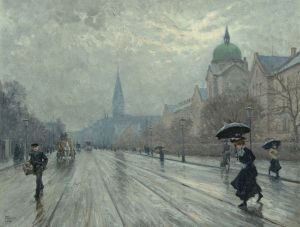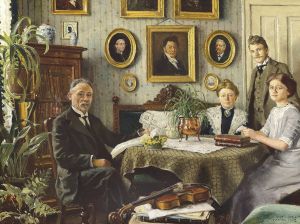
Changing of the guard at Amalienborg Palace
A hand-painted replica of Paul Fischer’s masterpiece Changing of the guard at Amalienborg Palace, meticulously crafted by professional artists to capture the true essence of the original. Each piece is created with museum-quality canvas and rare mineral pigments, carefully painted by experienced artists with delicate brushstrokes and rich, layered colors to perfectly recreate the texture of the original artwork. Unlike machine-printed reproductions, this hand-painted version brings the painting to life, infused with the artist’s emotions and skill in every stroke. Whether for personal collection or home decoration, it instantly elevates the artistic atmosphere of any space.
Paul Fischer's painting "Changing of the Guard at Amalienborg Palace" captures a quintessential moment in Danish royal tradition. Paul Fischer, a Danish artist born in 1860, was renowned for his ability to depict everyday life in Copenhagen with a keen eye for detail and a vibrant palette. His works often reflect the cultural and social atmosphere of Denmark during the late 19th and early 20th centuries.
Amalienborg Palace, located in the heart of Copenhagen, is the official residence of the Danish royal family. It consists of four identical classical palace façades with rococo interiors around an octagonal courtyard. The palace has been the home of the Danish monarchy since 1794, following a fire at Christiansborg Palace. The changing of the guard at Amalienborg is a ceremonial event that has become a popular attraction for both locals and tourists.
Fischer's painting likely depicts this ceremonial event with a focus on the precision and pageantry of the Royal Life Guards. The guards are known for their distinctive uniforms, which include bearskin hats and blue tunics, and their role is both ceremonial and protective, as they are responsible for the security of the royal family. The changing of the guard occurs daily at Amalienborg, and it is a tradition that dates back centuries, symbolizing the continuity and stability of the Danish monarchy.
In Fischer's work, the viewer can observe the meticulous attention to detail that characterizes his style. The artist captures not only the guards in their formal attire but also the architectural grandeur of Amalienborg Palace itself. The painting may include spectators, reflecting the public interest in royal ceremonies and the connection between the monarchy and the Danish people.
Fischer's ability to convey the atmosphere of Copenhagen and its cultural landmarks is evident in this painting. His works often serve as historical documents, providing insight into the urban life and traditions of Denmark during his lifetime. "Changing of the Guard at Amalienborg Palace" is no exception, as it encapsulates a moment of national pride and tradition.
The painting is a testament to Fischer's skill in capturing the essence of Danish culture and his contribution to the documentation of Copenhagen's historical and social landscape. Through his art, Fischer offers a window into the past, allowing contemporary audiences to appreciate the rich heritage of Denmark and the enduring significance of its royal traditions.
While specific details about the painting's creation, such as its exact date or current location, may not be readily available, its significance lies in its representation of a timeless tradition. Fischer's work continues to be celebrated for its artistic merit and its role in preserving the cultural history of Denmark.












